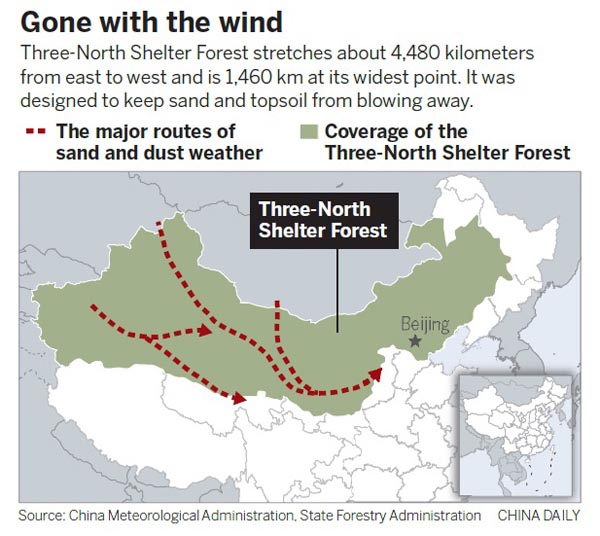


The second sandstorm in a week, carried by strong winds, covered a large area of the north on Thursday and was forecast to linger into Friday, the national weather authority said on Thursday.
The storm arrived as the State Forestry Administration said the country's expanding shelter forest has worked better in reducing the dust in the originating areas but did little to block the long-distance storm.
At least seven provincial regions, including the Inner Mongolia autonomous region, Shanxi province and the Hebei-Beijing-Tianjin area, were engulfed by sand and dust in gusting winds on Thursday, the same areas hit by the year's strongest sandstorm a week earlier, the China Meteorological Administration said.
The dusty weather is forecast to affect fewer regions, and with less severity. For example, Beijing saw the reading for PM10 - a major pollutant in dusty weather - climbing to 400 micrograms per cubic meter at noon on Thursday, according to the city's environmental monitoring bureau.
On May 4, the peak reading of PM10 in Beijing exceeded 1,000 mcg/cu m and turned the sky a murky yellow. That sandstorm engulfed one-sixth of the country for two days, and the low visibility affected roads and flights in some cities.
In the latest sandstorm, dust engulfed northern regions quickly and caused severe air pollution, making some people question the influence of the shelter forest, which is supposed to stop the sand.
Since 1978, the central government has planted trees and expanded forests along the northwestern, north and northeastern regions, collectively called the Three-North Shelter Forest Program, the world's largest forestation project.
To date, the reforestation covers over 290,000 square kilometers, and by 2020, the new woodlands will be expanded by over 16,400 sq km, according to the State Forestry Administration's Three-North Forest Shelter Bureau.
The shelter forest has stretched through regions prone to dusty weather. The national weather authority determined two-thirds of the sandstorms formed in the southern part of Mongolia and got stronger in Inner Mongolia.
In response to public concern regarding the forest's effects on the recent sandy weather, Zhang Bihui, a senior meteorologist at the weather authority, explain-ed: "The sand and dust (in the sandstorms on May 4 and 5) were carried aloft by upper air currents, over 5,000 meters high, which is why the forest had little effect."
Hong Jiayi, deputy head of the forest shelter bureau, said the upper limit that the forest can work in stopping sand is the height of the trees.
"The forest has reduced the dust by increasing the vegetation coverage to slow down the wind near the ground, control the dust from rising off the ground and forcing the flying dust settle down when it passes through the forest," he said.
The forest cannot change the air currents as some people thought, he added.
Researchers have found the shelter forest works in reducing dust storms in local areas and in changing desert into farmland or grassland, said Li Xinrong, a researcher on deserts with the Chinese Academy of Sciences.
In 2015, sandy land area in China had been reduced by 9,902 sq km compared with 2009, a national desert survey showed.
Zhang said China has had seven instances of dusty or sandy weather between Jan 1 and May 6, lower than the average of nearly 12 over the same period since 2000.
In the long run, the expanding shelter forest has worked in controlling dusty weather, forestry and weather authorities said.
 Top 10 Chinese tech and engineering marvels
Top 10 Chinese tech and engineering marvels Chinese footwear tycoon brings jobs, economic benefits to Ethiopia
Chinese footwear tycoon brings jobs, economic benefits to Ethiopia China develops reusable spacecraft for manned lunar missions
China develops reusable spacecraft for manned lunar missions More ‘agile fleets needed’ to tackle sea challenges
More ‘agile fleets needed’ to tackle sea challenges Delivery boy becomes the third richest man in China
Delivery boy becomes the third richest man in China China to build 30,000 new kilometers of railway before 2020
China to build 30,000 new kilometers of railway before 2020 Absence of regulations casts shadow on China’s booming UAV industry
Absence of regulations casts shadow on China’s booming UAV industry China's place on world governance index sets unique example for developing countries
China's place on world governance index sets unique example for developing countries Expectations high for China-Vatican relations in 2017
Expectations high for China-Vatican relations in 2017 The power of 'She' in China
The power of 'She' in China Seven most beautiful art museums in China
Seven most beautiful art museums in China Top 10 European patent applicants in 2016
Top 10 European patent applicants in 2016 Chasing the world's prettiest flowers
Chasing the world's prettiest flowers Xi calls on Moon Jae-in to cement mutual trust
Xi calls on Moon Jae-in to cement mutual trust
 China prioritizes a ‘Green Belt and Road’
China prioritizes a ‘Green Belt and Road’ Can Moon chart independent diplomatic course for South Korea?
Can Moon chart independent diplomatic course for South Korea?
 New rules aim to make online platforms take more responsibility for user content
New rules aim to make online platforms take more responsibility for user content
Day|Week